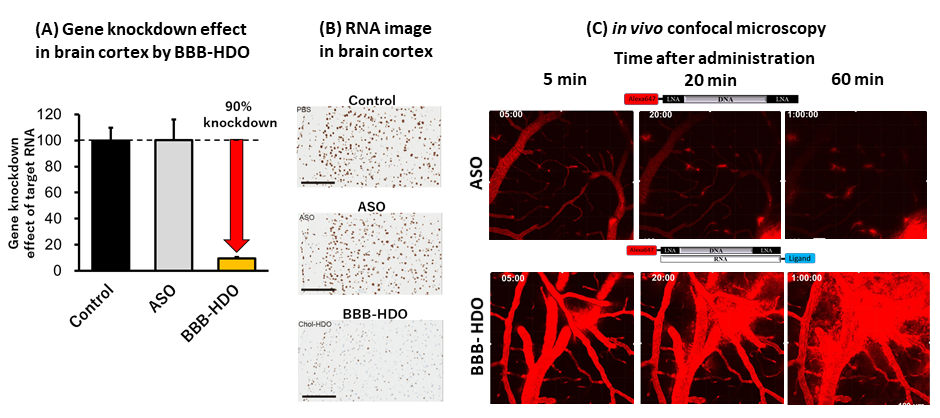From blood to brain: delivering nucleic acid therapy to the CNS
Watch video on YouTube: https://www.youtube.com/watch?v=5us0bzH4GAk
Tokyo, Japan - Antisense oligonucleotide (ASO) therapy has the potential to ameliorate many neurodegenerative diseases at the genetic level to suppress the production of harmful proteins or non-coding RNAs. Previously, achieving delivery of ASO with adequate concentrations in the central nervous system (CNS) with systemic dosing was difficult. Now, researchers from Japan and the USA have developed a drug delivery platform that overcomes this hurdle.
Evolution has equipped the brain with protection against both mechanical and molecular injury. The blood–brain barrier (BBB) is a selectively semipermeable barricade of endothelial cells lining the capillaries; working with specific transporter proteins, it functions as a fastidious gatekeeper between the circulation and the CNS, barring foreign molecules, including drugs.
ASOs are pharmaceutical molecules that can target disease at the genetic level. They comprise a few dozen base pairs arranged in an ‘antisense’ or reverse order and prevent production of pathogenic proteins through binding to the ‘sense’ strand of mRNA targets. Single-stranded ASOs show great promise against CNS disorders such as spinal muscular atrophy. However, they do not enter the CNS effectively following systemic administration and require direct intrathecal injection. This may be hazardous particularly for patients with lumbar spinal deformity or on blood-thinners.
The research team had recently developed DNA/RNA heteroduplex oligonucleotide (HDO) technology capable of highly efficient RNA degradation in vivo. First author Tetsuya Nagata explains, “We found that cholesterol conjugated HDO (Chol-HDO), unlike cholesterol-ASO, efficiently reached the CNS following subcutaneous or intravenous administration in experimental animals. The Chol-HDO platform showed significant dose-dependent target gene reductions with prolonged action in all CNS regions and cell types.”
Further, the researchers confirmed that this beneficial outcome was not at the expense of vascular barrier integrity. They also investigated the pharmacokinetics of multiple injections as well as subcutaneous dosing (which may be self-administered). Additionally, the effects were confirmed across species and against other neurogenerative disease gene targets such as myotonic dystrophy type 1, Alexander disease and amyotrophic lateral sclerosis.
“Systemic doses being higher, adverse effects such as mild decrease in platelets were expected,” says Nagata. “However, divided or subcutaneous dosing can rescue these. We may also strategize by initiating treatment with intrathecal dosing to rapidly achieve therapeutic concentrations, followed by intravenous or subcutaneous maintenance as needed.”
“Our innovative therapeutic platform for blood-to-brain delivery of ASOs may revolutionize management of neurodegenerative diseases,” senior author Takanori Yokota claims. “Future research will help define the specific molecular pathways thus optimizing delivery of ASO pharmacotherapy to the CNS.”

Figure
(A) Drastic target gene (RNA) suppression in the cerebral cortex when Blood-brain-barrier heteroduplex oligonucleotide (BBB-HDO) administered intravenously to mice. (B) RNA images in the cerebral cortex after administration of BBB-HDO to mice. The brown signal indicates RNA, but the signal is almost completely suppressed by BBB-HDO. (Scale: 100 μm). (C) Live image of mouse brain observed by in vivo confocal laser microscopy. The single-stranded antisense oligonucleotide (ASO) remains in the blood vessels of the brain, while the BBB-HDO is directly transferred into the brain.
The article, “Systemically administered DNA/RNA heteroduplex oligonucleotides achieve blood to brain delivery and efficient gene knockdown in the CNS” was published in Nature Biotechnology at DOI:10.1038/s41587-021-00972-x
Summary
Journal Article
TITLE:Systemically administered DNA/RNA heteroduplex oligonucleotides achieve blood to brain delivery and efficient gene knockdown in the CNS
DOI:http://dx.doi.org/10.1038/s41587-021-00972-x
Correspondence to
Department of Neurology and Neurological Science,
Graduate School of Medical and Dental Sciences,
Tokyo Medical and Dental University (TMDU)
Phone:+81-3-5803-5233 Fax:+81-3-5803-0169
E-mail: tak-yokota.nuro(at)tmd.ac.jp
*Please change (at) in e-mail addresses to @ on sending your e-mail to contact personnels.

